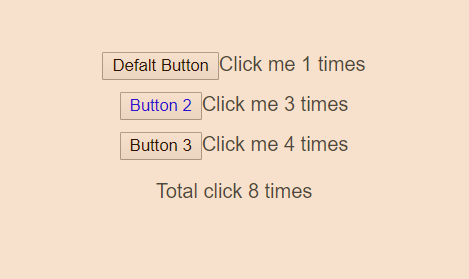Vue的兩大核心 1. 數據驅動 - 數據驅動界面顯示2. 模塊化 - 復用公共模塊,組件實現模塊化提供基礎 組件基礎 組件渲染過程 template > ast(抽象語法樹) > render > VDom(虛擬DOM) > 真實的Dom > 頁面 Vue組件需要編譯,編譯過程可能發生在 打包過程 ...
Vue的兩大核心
1. 數據驅動 - 數據驅動界面顯示
2. 模塊化 - 復用公共模塊,組件實現模塊化提供基礎
組件基礎
組件渲染過程
template ---> ast(抽象語法樹) ---> render ---> VDom(虛擬DOM) ---> 真實的Dom ---> 頁面
Vue組件需要編譯,編譯過程可能發生在
- 打包過程 (使用vue文件編寫)
- 運行時(將字元串賦值template欄位,掛載到一個元素上並以其 DOM 內部的 HTML 作為模板)
對應的兩種方式 runtime-only vs runtime-compiler
runtime-only(預設)
- 打包時只包含運行時,因此體積更少
- 將template在打包的時候,就已經編譯為render函數,因此性能更好
runtime-compiler
- 打包時需要包含(運行時 + 編譯器),因此體積更大,大概多10Kb
- 在運行的時候才把template編譯為render函數,因此性能更差
啟用runtime-compiler
vue.config.js(若沒有手動創建一個)
module.exports = { runtimeCompiler: true //預設false }
組件定義
1. 字元串形式定義(不推薦)
例子
const CustomButton = { template: "<button>自定義按鈕</button>" };
這種形式在運行時才把template編譯成render函數,因此需要啟用運行時編譯(runtime-compiler)
2. 單文件組件(推薦)
創建.vue尾碼的文件,定義如下
<template>
<div>
<button>自定義按鈕</button>
</div>
</template>
<template> 里只能有一個根節點,即第一層只能有一個節點,不能多個節點平級
這種形式在打包的時就編譯成render函數,因此跟推薦這種方式定義組件
組件註冊
1. 全局註冊
全局註冊是通過Vue.component()註冊
import CustomButton from './components/ComponentDemo.vue'
Vue.component('CustomButton', CustomButton)
優點
- 其他地方可以直接使用
- 不再需要components指定組件
缺點
- 全局註冊的組件會全部一起打包,增加app.js體積
適合
- 基礎組件全局註冊
2. 局部註冊
在需要的地方導入
<template>
<div id="app">
<customButton></customButton>
</div>
</template>
<script>
import CustomButton from "./components/ComponentDemo.vue";
export default {
name: "App",
components: { CustomButton }
};
</script>
優點
- 按需載入
缺點
- 每次使用必須導入,然後components指定
適合
- 非基礎組件
組件使用
組件復用
<template>
<div id="app">
<img alt="Vue logo" src="./assets/logo.png" />
<customButton></customButton>
<customButton></customButton>
<customButton></customButton>
</div>
</template>
customButton 組件
<template>
<div id="app">
<button @click="increment">click me {{times}} times</button>
</div>
</template>
<script>
export default {
data() {
return { times: 0 };
},
methods: {
increment() {
return this.times++;
}
}
};
</script>
每個組件都會創建一個新實例,組件的data必須是function,因為每個實例維護自己的data數據
組件傳參
1. 通過props屬性
定義一個button,按鈕文本通過props傳入
<template>
<button> {{buttonText}} </button>
</template>
<script>
export default {
props: {
buttonText: String
}
};
</script>
調用者通過attribute傳入
<customButton buttonText="Button 1"></customButton> <customButton buttonText="Button 2"></customButton> <customButton buttonText="Button 3"></customButton>
運行效果

2. 通過插槽<slot></slot>
組件在需要替換的地方放入插槽<slot></slot>
<template> <button style="margin:10px"><slot>Defalt Button</slot></button> </template> <script> export default { props: { buttonText: String } }; </script>
調用者的innerHtml會替換插槽的值,若為空,使用預設的
<customButton></customButton> <customButton><span style="color:blue">Button 2</span></customButton> <customButton>Button 3</customButton>
運行效果

註意:看到是用自定義組件的innerHtml替換插槽,若插槽只有一個,可以不寫name attribute,若多個插槽需指定插槽name attribute
自定義事件
1. 在組件內部調用this.$emit觸發自定義事件
<template>
<div style="margin:10px">
<button @click="increment">
<slot>Defalt Button</slot>
</button>
<span>Click me {{times}} times</span>
</div>
</template>
<script>
export default {
props: {
buttonText: String
},
data() {
return { times: 0 };
},
methods: {
increment() {
this.times++;
("increment");
}
}
};
</script>
2. 調用者監聽自定義事件
<template>
<div id="app">
<customButton @increment="handleIncrement"></customButton>
<customButton @increment="handleIncrement">
<span style="color:blue">Button 2</span>
</customButton>
<customButton @increment="handleIncrement">Button 3</customButton>
<p>Total click {{totalClicks}} times</p>
</div>
</template>
<script>
import CustomButton from "./components/ComponentDemo.vue";
export default {
name: "App",
components: { CustomButton },
data() {
return { totalClicks: 0 };
},
methods: {
handleIncrement() {
this.totalClicks++;
}
}
};
</script>
3. 運行效果

轉發請標明出處:https://www.cnblogs.com/WilsonPan/p/12763404.html



